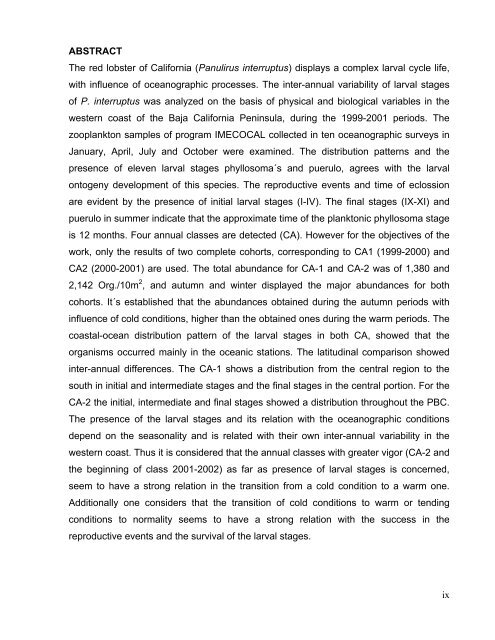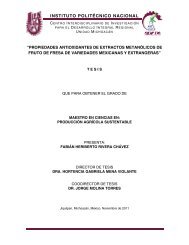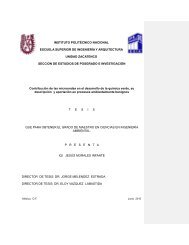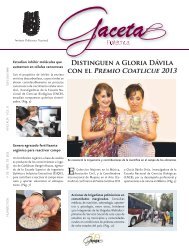Ver/Abrir - Repositorio Digital - Instituto Politécnico Nacional
Ver/Abrir - Repositorio Digital - Instituto Politécnico Nacional
Ver/Abrir - Repositorio Digital - Instituto Politécnico Nacional
You also want an ePaper? Increase the reach of your titles
YUMPU automatically turns print PDFs into web optimized ePapers that Google loves.
ABSTRACT<br />
The red lobster of California (Panulirus interruptus) displays a complex larval cycle life,<br />
with influence of oceanographic processes. The inter-annual variability of larval stages<br />
of P. interruptus was analyzed on the basis of physical and biological variables in the<br />
western coast of the Baja California Peninsula, during the 1999-2001 periods. The<br />
zooplankton samples of program IMECOCAL collected in ten oceanographic surveys in<br />
January, April, July and October were examined. The distribution patterns and the<br />
presence of eleven larval stages phyllosoma´s and puerulo, agrees with the larval<br />
ontogeny development of this species. The reproductive events and time of eclossion<br />
are evident by the presence of initial larval stages (I-IV). The final stages (IX-XI) and<br />
puerulo in summer indicate that the approximate time of the planktonic phyllosoma stage<br />
is 12 months. Four annual classes are detected (CA). However for the objectives of the<br />
work, only the results of two complete cohorts, corresponding to CA1 (1999-2000) and<br />
CA2 (2000-2001) are used. The total abundance for CA-1 and CA-2 was of 1,380 and<br />
2,142 Org./10m 2 , and autumn and winter displayed the major abundances for both<br />
cohorts. It´s established that the abundances obtained during the autumn periods with<br />
influence of cold conditions, higher than the obtained ones during the warm periods. The<br />
coastal-ocean distribution pattern of the larval stages in both CA, showed that the<br />
organisms occurred mainly in the oceanic stations. The latitudinal comparison showed<br />
inter-annual differences. The CA-1 shows a distribution from the central region to the<br />
south in initial and intermediate stages and the final stages in the central portion. For the<br />
CA-2 the initial, intermediate and final stages showed a distribution throughout the PBC.<br />
The presence of the larval stages and its relation with the oceanographic conditions<br />
depend on the seasonality and is related with their own inter-annual variability in the<br />
western coast. Thus it is considered that the annual classes with greater vigor (CA-2 and<br />
the beginning of class 2001-2002) as far as presence of larval stages is concerned,<br />
seem to have a strong relation in the transition from a cold condition to a warm one.<br />
Additionally one considers that the transition of cold conditions to warm or tending<br />
conditions to normality seems to have a strong relation with the success in the<br />
reproductive events and the survival of the larval stages.<br />
ix
















